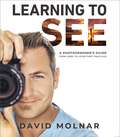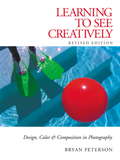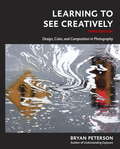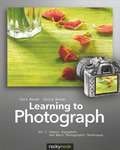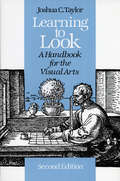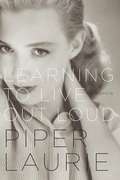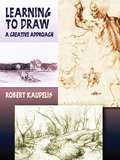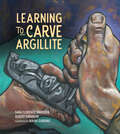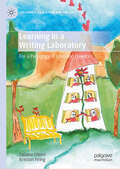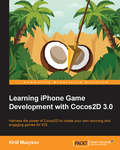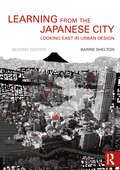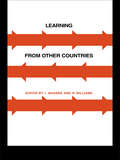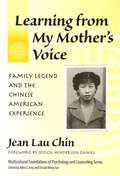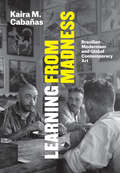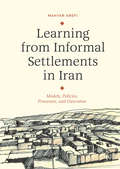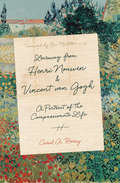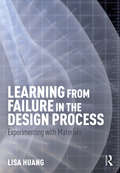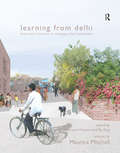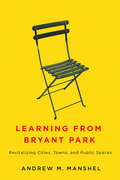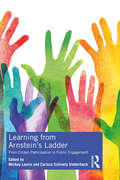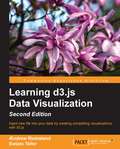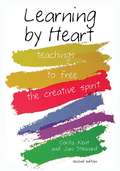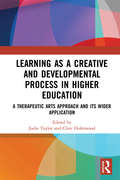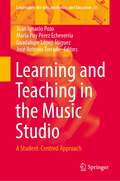- Table View
- List View
Learning to See: A Photographer’s Guide from Zero to Your First Paid Gigs
by David MolnarWhether you want to take better photos in your everyday life or make a full-time income as a photographer, the five-part framework author David Molnar teaches in Learning to See will work for you:See: have a vision for your shot and execute that visionShoot: become technically proficient with your cameraEdit: help re-create the emotion from the day of the shootDevelop: identify your area of focus for photographyEarn: start getting paid for your artIt&’s a proven process every photographer follows but few talk about. But if you use it, it will shave years off the learning curve he himself went through as an amateur photographer. This book teaches readers to learn to see, because in the end, that&’s what a photographer does: notice what other people often miss and understand how to capture those things in a masterful way.
Learning to See Creatively: Design, Color and Composition in Photography (Revised Edition)
by Bryan PetersonAlmost everyone can "see" in the conventional sense, but developing photographic vision takes practice. Learning to See Creatively helps photographers visualize their work, and the world, in a whole new light. Now totally rewritten, revised, and expanded, this best-selling guide takes a radical approach to creativity. It explains how it is not some gift only for the "chosen few" but actually a skill that can be learned and applied. Using inventive photos from his own stunning portfolio, author and veteran photographer Bryan Peterson deconstructs creativity for photographers. He details the basic techniques that went into not only taking a particular photo, but also provides insights on how to improve upon it--helping readers avoid the visual pitfalls and technical dead ends that can lead to dull, uninventive photographs. This revised edition features the latest information on digital photography and digital imaging software, as well as an all-new section on color as a design element. Learning to See Creatively is the definitive reference for any photographers looking for a fresh perspective on their work. * Updated to include digital * All new artwork, and a totally revised and expanded text * All-new section on color as a design element.
Learning to See Creatively, Third Edition
by Bryan PetersonCompletely revised and updated throughout, Bryan Peterson's classic guide to creativity helps photographers visualize their work, and the world, in a whole new light by developing their photographic vision. Fully revised with 100 percent new photography, this best-selling guide takes a radical approach to creativity by explaining how it is not just an inherent ability but a skill that can be learned and applied. Using inventive photos from his own stunning portfolio, author and veteran photographer Bryan Peterson deconstructs creativity for photographers. He details the basic techniques that go into not only taking a particular photo, but also provides insights on how to improve upon it--helping readers avoid the visual pitfalls and technical dead ends that can lead to dull, uninventive photographs. This revised edition features a complete section on color as a design element and all new photographs to illustrate Peterson's points. Learning to See Creatively is the definitive reference for any photographer looking for a fresh perspective on their work.
Learning to Photograph - Volume 2
by Georg Banek Cora BanekThe two volumes of the Learning to Photograph series give students and interested amateur photographers essential information about technique and design as well as an understanding of the big concepts of photography. Beginning and advanced photographers alike will find the content instructive, thoroughly explained, and effectively illustrated, making this book a useful resource for readers to develop their own craft. This second volume addresses the topics of visual design and composition. The authors describe various methods of visual design and how you can use these methods effectively. You will learn which techniques to use to design your images while at the same time training your photographic eye. You will develop the ability to support the message of your subject purposefully, hone your photographic style, and analyze your own work and the work of others competently. The striking images and informational graphics not only illustrate the concepts at hand, but also make the lessons visually pleasing and offer useful examples for readers to mimic in their own work. Topics include: Visual perception Composition, shapes, and lines Managing light Color and its effects Sharpness, blur, and movement The interplay of visual design elements Image analysis and evaluation The previous volume in the Learning to Photograph series addresses cameras, equipment, and basic photographic techniques.
Learning to Look: A Handbook for the Visual Arts, Second Edition
by Joshua C. TaylorSometimes seeing is more difficult for the student of art than believing. Taylor, in a book that has sold more than 300,000 copies since its original publication in 1957, has helped two generations of art students "learn to look. " This handy guide to the visual arts is designed to provide a comprehensive view of art, moving from the analytic study of specific works to a consideration of broad principles and technical matters. Forty-four carefully selected illustrations afford an excellent sampling of the wide range of experience awaiting the explorer. The second edition of Learning to Look includes a new chapter on twentieth-century art. Taylor's thoughtful discussion of pure forms and our responses to them gives the reader a few useful starting points for looking at art that does not reproduce nature and for understanding the distance between contemporary figurative art and reality.
Learning to Live Out Loud: A Memoir
by Piper LaurieAn intimate memoir by three-time Oscar nominee Piper Laurie, one of Hollywood's most gifted and respected actressesAt the age of seventeen, in the glory days of movie-making, Piper Laurie was living every little girl's dream. Having been selected by Universal Studios to be a contract star, Piper was removed from her acting class and provided with stylists, chaperones, leading roles, and handsome dates, and elevated to the heights of Hollywood. Her beauty was admired by the likes of Ronald Reagan, Howard Hughes, Paul Newman, Tony Curtis, as well as dozens of directors and legions of fans. Her name was emblazoned on marquees across America for hit movies of the fifties such as the The Prince Who Was a Thief, The Mississippi Gambler, and Ain't Misbehavin'. But Piper discovered early on that the little girl's dream was not her own. Mortified by the shallowness of the roles and movies she was given, she longed for the freedom and fulfillment of her own artistic vision. After years in the studio system, shy Piper Laurie found her voice and the courage to burn her contract. It was only after she left the oppressive studio culture that she began to star in the TV shows, plays, and films that truly became the hallmarks of her career: The Glass Menagerie on Broadway, the original Days of Wine and Roses, The Hustler, the iconic Carrie, and Twin Peaks. She grew into a three-time Oscar-nominated actress, an accomplished sculptor, and a director. This memoir is the inspiring tale of Piper's perseverance to break from tradition and to practice her craft at the highest level. She started life as a withdrawn, mute child who couldn't find her voice and was transformed into a woman who learned to live out loud by her own rules.From the Hardcover edition.
Learning to Draw: A Creative Approach (Dover Art Instruction)
by Robert KaupelisTeachers, students, and amateur artists will all benefit from the advice of this esteemed educator and fine artist whose book, as described by a colleague, is "a cause célèbre for art education, not only because it meets the urgent professional need, but also because it combines artistic, aesthetic, and instructional considerations in a way which is significantly different from any other text."Encouraging teachers and students to use his suggestions in ways they feel most appropriate, the author (an expert guide and teacher) offers sound advice on methods and techniques for artists at all levels. Using the lessons and methods he employed over the years as an instructor, Kaupelis focuses on solving the problems common to many illustrators, among them successfully developing perspective, contour and modeled drawing, and drawing from memory and projected images. A splendid blend of instruction, analysis, and insights, this volume--one of the most widely read art instruction texts--deserves a place on the shelves of instructors and serious students of art.
Learning to Carve Argillite (Sk'ad'a Stories Series)
by Robert Davidson Sara Florence DavidsonBased on Haida artist Robert Davidson's own childhood experiences, this beautiful story highlights learning through observation, as well as the role of Elders in sharing knowledge and mentorship.Learning to carve is a lifelong journey. With the help of his father and grandfather, a boy on Haida Gwaii practises to become a skillful carver. As he carefully works on a new piece, he remembers a trip to Slatechuck Mountain to gather the argillite, as well as his father&’s words about the importance of looking back to help us find our way.Written by the creators of Potlatch as Pedagogy, this book brings the Sk'ad'a Principles to life through the art of Janine Gibbons.
Learning to Carve Argillite (Sk'ad'a Stories Series)
by Robert Davidson Sara Florence DavidsonBased on Haida artist Robert Davidson's own childhood experiences, this beautiful story highlights learning through observation, as well as the role of Elders in sharing knowledge and mentorship.Learning to carve is a lifelong journey. With the help of his father and grandfather, a boy on Haida Gwaii practises to become a skillful carver. As he carefully works on a new piece, he remembers a trip to Slatechuck Mountain to gather the argillite, as well as his father&’s words about the importance of looking back to help us find our way.Written by the creators of Potlatch as Pedagogy, this book brings the Sk'ad'a Principles to life through the art of Janine Gibbons.
Learning in a Writing Laboratory: For a Pedagogy of Love and Freedom (Creativity, Education and the Arts)
by Tatiana Chemi Kristian FiringThis book is an exploration of a collective writing laboratory designed to stimulate creativity and critical reflection for education professionals. The authors uncover how a writing lab can help educators develop their teaching practices and identities by means of critical-creative, collaborative, relational and arts-based methodologies. A theoretical insight into pedagogies of love and freedom illustrating how laboratory practices in education can become acts of daily care, the book will appeal to students and scholars of education, arts-based methods and creativity.
Learning iPhone Game Development with Cocos2D 3.0
by Kirill MuzykovThis book is an easy-to-follow, step-by-step beginner's guide covering the full process of creating a game. It is packed with examples and illustrations, with comprehensive coverage of each topic. If you want to learn how to make games using the Cocos2D framework, this book is for you. If you would like to build a good foundation for a career in game development as an independent game developer or at a game studio, or if you just want to make games as a hobby, then you'll love this book. You should have some basic programming experience with Objective-C and Xcode. To run the code in this book, you will also need an Intel-based Macintosh running OS X Mountain Lion (or later).
Learning from the Japanese City: Looking East in Urban Design (Planning, History and Environment Series)
by Barrie SheltonJapanese cities are amongst the most intriguing and confounding anywhere. Their structures, patterns of building and broader visual characteristics defy conventional urban design theories, and the book explores why this is so. Like its cities, Japan’s written language is recognized as one of the most complicated, and the book is unique in revealing how the two are closely related. Set perceptively against a sweep of ideas drawn from history, geography, science, cultural and design theory, Learning from the Japanese City is a highly original exploration of contemporary urbanism that crosses disciplines, scales, time and space. This is a thoroughly revised and much extended version of a book that drew extensive praise in its first edition. Most parts have stood the test of time and remain. A few are replaced or removed; about a hundred figures appear for the first time. Most important is an entirely new (sixth) section. This brings together many of the urban characteristics, otherwise encountered in fragments through the book, in one walkable district of what is arguably Japan’s most convenient metropolis, Nagoya. The interplay between culture, built form and cities remains at the heart of this highly readable book, while a change in subtitle to Looking East in Urban Design reflects increased emphasis on real places and design implications.
Learning from Other Countries: The Cross-National Dimension in Urban Policy Making
by Ian Masser and Richard WilliamsLooking at the lessons we can learn from international research in urban and regional planning, this book explores the challenges in using cross-country studies. The contributors address how to approach researching planning in other countries, and how to then diffuse the planning information. Key topics include: comparable urban data, and how to use it working with international agencies methodological issues in cross-country research translating theory into practice Case studies include researching new towns in France and Poland, and problems doing empirical work in Eastern Europe.
Learning from My Mother's Voice: Family Legend and the Chinese American Experience
by Jean Lau Chin"As the reader takes Jean Lau Chin's guided tours through myth and cultural history, it is clear that these stories are more than entertainment: They represent cultural messages about living as a woman. The juxtaposition of Chinese and Western myths with their similarities and differences, followed by the author's incisive analysis of contemporary stories depicting Asian women in print and on the screen, provide culturally driven connections to perceptions and behaviors of Chinese women both individually and in relation to the world. Through these stories, a rich tapestry of information about Chinese women and Chinese American women emerges. The stereotypical Chinese woman fails to appear as the various lenses of ethnicity, gender, location, and epoch make explicit the diversity that exists within any ethnic group and liberate us by providing an informed array of images and possibilities." From Book
Learning from Madness: Brazilian Modernism and Global Contemporary Art
by Kaira M. CabañasThroughout the history of European modernism, philosophers and artists have been fascinated by madness. Something different happened in Brazil, however, with the “art of the insane” that flourished within the modernist movements there. From the 1920s to the 1960s, the direction and creation of art by the mentally ill was actively encouraged by prominent figures in both medicine and art criticism, which led to a much wider appreciation among the curators of major institutions of modern art in Brazil, where pieces are included in important exhibitions and collections. Kaira M. Cabañas shows that at the center of this advocacy stood such significant proponents as psychiatrists Osório César and Nise da Silveira, who championed treatments that included painting and drawing studios; and the art critic Mário Pedrosa, who penned Gestaltist theses on aesthetic response. Cabañas examines the lasting influence of this unique era of Brazilian modernism, and how the afterlife of this “outsider art” continues to raise important questions. How do we respect the experiences of the mad as their work is viewed through the lens of global art? Why is this art reappearing now that definitions of global contemporary art are being contested?Learning from Madness offers an invigorating series of case studies that track the parallels between psychiatric patients’ work in Western Europe and its reception by influential artists there, to an analogous but altogether distinct situation in Brazil.
Learning from Informal Settlements in Iran: Models, Policies, Processes, and Outcomes
by Mahyar ArefiThis book explores the tenacity of Iran’s informal settlements against the backdrop of the World Bank’s USD 80 million loan for physical upgrading. Arefi seeks to identify and unravel the distinctive models, policies, processes, and outcomes associated with it, and explains why—despite obvious challenges—informal settlements remain popular in Iran, and also how understanding them in a broader theoretical context helps rectify existing redevelopment policies in order to develop more effective ones.
Learning from Henri Nouwen and Vincent van Gogh: A Portrait of the Compassionate Life
by Carol A. BerryCarol Berry and her husband met and befriended Henri Nouwen when she sat in his course on compassion at Yale Divinity School in the 1970s. At the request of Henri Nouwen's literary estate, she has written this book, which includes unpublished material recorded from Nouwen's lectures. As an art educator, Berry is uniquely situated to develop Nouwen's work on Vincent van Gogh and to add her own research. She fills in background on the much misunderstood spiritual context of van Gogh's work, and reinterprets van Gogh's art (presented here in full color) in light of Nouwen's lectures. Berry also brings in her own experience in ministry, sharing how Nouwen and van Gogh, each in his own way, led her to the richness and beauty of the compassionate life.
Learning from Failure in the Design Process: Experimenting with Materials
by Lisa HuangLearning from Failure in the Design Process shows you that design work builds on lessons learned from failures to help you relax your fear of making mistakes, so that you’re not paralyzed when faced with a task outside of your comfort zone. Working hands-on with building materials, such as concrete, sheet metal, and fabric, you will understand behaviors, processes, methods of assembly, and ways to evaluate your failures to achieve positive results. Through material and assembly strategies of stretching, casting, carving, and stacking, this book uncovers the issues, problems, and failures confronted in student material experiments and examines built projects that addressed these issues with innovative and intelligent strategies. Highlighting numerous professional practice case studies with over 250 color images, this book will be ideal for students interested in materials and methods, and students of architecture in design studios.
Learning from Delhi: Dispersed Initiatives in Changing Urban Landscapes
by Written by Mitchell Shamoon PatwariThe inflexibility of modern urban planning, which seeks to determine the activities of urban inhabitants and standardise everyday city life, is challenged by the unstoppable organic growth of illegal settlements. In rapidly expanding cities, issues of continuity with local traditions, local conditions and local ways of working are juxtaposed with those of abrupt change due to emergency, reaction to modernity, environmental degradation, global market forces and global technological imperatives to make efforts to control by physical planning redundant as soon as they are enacted. In most third world cities there is little social welfare and almost no attempt at social housing. The urban poor must still house themselves with little or no state help to procure land or infrastructure. Not having a legal existence, 'slums' are automatically swept away to create a 'tabula rasa' prior to a complete new build for those who can afford the full cost. The notion of upgrading the existing built environment, has hardly entered the official planning vocabulary. Since 2002, both Diploma and latterly Degree students from London Metropolitan University Department of Architecture and Spatial Design have produced schemes from research work generated during an annual field trip to India. Work is focused on situations where rapid cultural and technical change is affecting traditional or transitional communities who have access to only limited resources. Sites have included post earthquake desert locations in Gujarat, under-serviced urban slums in Delhi, dense traditional city landscapes in Meerut and the integration of Marwari nomads into a settlement in Agra. This has proved a stimulating and provocative academic learning environment producing a range of innovative work. Some of the students involved have been awarded RIBA medals and other prestigious student prizes. In the course of this enterprise, links with Indian non-government organisations and architectural schools have developed providing a wealth of opportunity for further work, including a new MA and, while a first live project which will provide sanitation to a low income urban village in Agra is nearing completion, two other live projects: for primary education in a stone quarry near Mumbai and for a housing cooperative in north west Delhi, are just beginning. The course has been ground breaking and innovative in this area in that it seeks first to understand the cultural and physical patterns of old city labyrinths and illegal urban settlements before, and as an aid to, intervention. Extended physical and cultural surveys which up date the 'diagnostic' surveys first employed by Patrick Geddes in the early 20th century are carried out by the students. By understanding the historical, cultural and physical factors which underlie the current city fabric, students are able to propose and validate a range of schemes from simple conservative surgery carried out by the community alone, to working alongside cultures of resistance to provide alternatives to planned projects. They have also shown how major infrastructure projects can be tweaked in practice to add greater potential to those who use them. Unlike master planning this understanding does not seek to lay down a fossilised grid within which inhabitants must fit themselves. Rather than this, students design using a narrative approach to frame, capture and harness (however fleetingly) moments from the everyday to use as building blocks for their imagined proposals. Their schemes show how an 'untidy' mix of the old and the new, of memory and aspiration can, in a spirit of experiment and curiosity, give unique identity to place. Cities are in a process of constant renewal. The piecemeal reuse and adaptation of the existing urban fabric in an attempt to match the changing aspirations of its inhabitants is cost effective, environmentally sustainable and appropriate. The book is about this increasingly vital type of architectural work. It is also a testimony to the value of linking real live projects with education in the studio
Learning from Bryant Park: Revitalizing Cities, Towns, and Public Spaces
by Andrew M. ManshelBy the 1970s, 42nd Street in New York was widely perceived to be unsafe, a neighborhood thought to be populated largely by drug dealers, porn shops, and muggers. But in 1979, civic leaders developed a long-term vision for revitalizing one especially blighted block, Bryant Park. The reopening of the park in the 1990s helped inject new vitality into midtown Manhattan and served as a model for many other downtown revitalization projects. So what about urban policy can we learn from Bryant Park? In this new book, Andrew M. Manshel draws from both urbanist theory and his first-hand experiences as a urban public space developer and manager who worked on Bryant Park and later applied its strategies to an equally successful redevelopment project in a very different New York neighborhood: Jamaica, Queens. He candidly describes what does (and doesn’t) work when coordinating urban redevelopment projects, giving special attention to each of the many details that must be carefully observed and balanced, from encouraging economic development to fostering creative communities to delivering appropriate services to the homeless. Learning from Bryant Park is thus essential reading for anyone who cares about giving new energy to downtowns and public spaces.
Learning from Arnstein's Ladder: From Citizen Participation to Public Engagement
by Mickey Lauria and Carissa Schively SlotterbackSherry Arnstein, writing in 1969 about citizen involvement in planning processes in the United States, described a “ladder of citizen participation” that showed participation ranging from low to high. Arnstein depicted the failings of typical participation processes at the time and characterized aspirations toward engagement that have now been elevated to core values in planning practice. But since that time, the political, economic, and social context has evolved greatly, and planners, organizers, and residents have been involved in planning and community development practice in ways previously unforeseen. Learning from Arnstein’s Ladder draws on contemporary theory, expertise, empirical analysis, and practical applications in what is now more commonly termed public engagement in planning to examine the enduring impacts of Arnstein’s work and the pervasive challenges that planners face in advancing meaningful public engagement. This book presents research from throughout the world, including Australia, Brazil, India, Indonesia, Portugal, Serbia, and the United States, among others, that utilizes, critiques, revises, and expands upon Arnstein’s aspirational vision. It is essential reading for educators and students of planning.
Learning d3.js Data Visualization - Second Edition
by Swizec Teller Ændrew RininslandInject new life into your data by creating compelling visualizations with d3.js About This Book * Understand how to best represent your data by developing the right kind of visualization * Harness the power of D3 by building interactive and real-time data-driven web visualizations * This book will provide a strong foundation in designing compelling web visualizations with D3.js Who This Book Is For This book is for web developers, data scientists, and anyone interested in representing data through interactive visualizations on the web with D3. Some basic JavaScript knowledge is expected, but no prior experience with data visualization or D3 is required to follow this book. What You Will Learn * Gain a solid understanding of the common D3 development idioms * Be able to input data, transform it, and output it as a visualization * Add simple effects and user interactions to a visualization * Find out how to write basic D3 code for server using Node.js * Automate testing visualizations using Mocha * Achieve fluency in ES2015, the most modern version of JavaScript In Detail D3 has emerged as one of the leading platforms to develop beautiful, interactive visualizations over the web. We begin by setting up a strong foundation, then build on this foundation book will take you through the entire world of reimagining data using interactive, animated visualizations created in D3.js. In addition to covering the various features of D3.js to build a wide range of visualizations, we also focus on the entire process of representing data through visualizations so that developers and those interested in data visualization will get the entire process right. We also include chapters that explore a wide range of visualizations through practical use cases. By the end of this book, you will have unlocked the mystery behind successful data visualizations and will be ready to use D3 to transform any data into a more engaging and sophisticated visualization. Style and approach This book has comprehensive explanation on how to leverage the power of D3.js to create powerful and creative visualizations through step by step instruction
Learning by Heart: Teachings to Free the Creative Spirit
by Corita Kent Jan StewardTap into your natural ability to create!* Engaging, proven exercises for developing creativity* Priceless resource for teachers, artists, actors, everyoneArtist and educator Corita Kent inspired generations of artists, and the truth of her words "We can all talk, we can all write, and if the blocks are removed, we can all draw and paint and make things" still shines through. This revised edition of her classic work Learning by Heart features a new foreword and a chart of curriculum standards. Kent's original projects and exercises, developed through more than 30 years as an art teacher and richly illustrated with 300 thought-provoking images, are as inspiring and as freeing today as they were during her lifetime. Learn how to challenge fears, be open to new directions, recognize connections between objects and ideas, and much more in this remarkable, indispensable guide to freeing the creative spirit within all of us. With new material by art world heavyweights Susan Friel and Barbara Loste, Learning by Heart brings creative inspiration into the 21st century!
Learning as a Creative and Developmental Process in Higher Education: A Therapeutic Arts Approach and Its Wider Application
by Clive Holmwood Judie TaylorMuch has been written about the importance of creativity in learning and education over the last few decades. This unique book extends beyond the usual focus on implementing creative methods in learning, teaching and assessing within higher education, to an examination of creativity as central to a learning process which is transformational for the student. More specifically, Learning as a Creative and Developmental Process in Higher Education examines the importance of a facilitative tutor-student relationship and environment which contextualise this creative process of teaching and learning. Bringing together unique teaching and learning approaches developed by experienced academics, this book discusses a number of complex issues, including approaches to an understanding of the student’s self-concept as learner; the nature of the curriculum; the potential of metaphor and creativity; and a multi-modal approach to learning and teaching. Contributions to the book also examine some of the challenges and tensions of such an approach within the context of arts-based subjects in higher education institutions. Using a unique and coherent thematic structure that is based upon the student journey as a transformational process, this book provides a new way of understanding the student journey through higher education. Including an examination of the parallels between educational and arts education and arts therapies disciplines, this book will be of interest to researchers, academics and postgraduate students involved in the arts and the arts therapies, as well as those studying creativity in teaching and learning in higher education. It should be of particular interest to those involved in the teaching and training of teachers and lecturers in higher education.
Learning and Teaching in the Music Studio: A Student-Centred Approach (Landscapes: the Arts, Aesthetics, and Education #31)
by Juan Ignacio Pozo María Puy Pérez Echeverría Guadalupe López-Íñiguez José Antonio TorradoThis book advocates for a radical change in music teaching and learning methods, allowing for a break from the traditional conservatory model still in use in many classrooms. The product of twenty years of interdisciplinary work by musicians, music teachers, and psychologists, the book proposes to place the focus of music education on the students themselves and on their mental and physical activity, with the aim of helping them to manage their own goals and emotions. This alternative is based on a new theoretical framework, as well as numerous real, concrete examples of how to put it into practice with students of different ages and in different environments. This book focuses primarily on teaching instrumental music, but its content will be useful for any teacher, student, musician, or researcher interested in improving music education in any environment, whether formal or informal, in which it takes placeChapters 3, 4, 6 and 18 are available open access under a Creative Commons Attribution 4.0 International License via link.springer.com.
